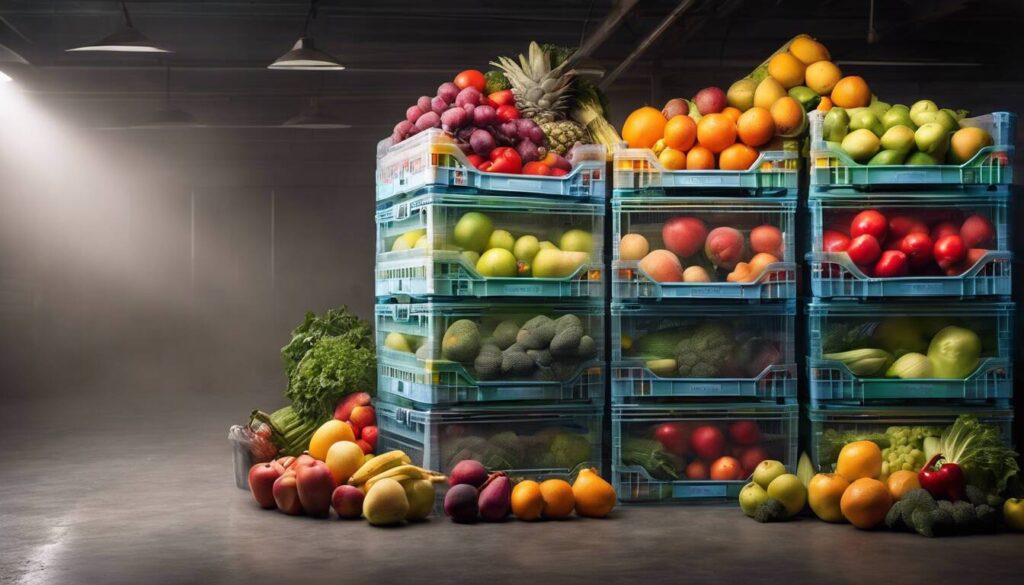Purchase cold temperature packaging for the transportation of your produce here. Cold temperature packaging is essential in transport to keep your food fresh. It uses special materials that can keep cool inside. This helps to keep fruits and veggies as fresh as possible despite traveling long distances.
Contact Us for a Free Temp Control Packaging Quote
Proper cold temperature packaging for produce involves using insulated containers or boxes, adding ice packs or dry ice to maintain the required temperature, and sealing the packaging securely to prevent heat transfer. Our comprehensive guide provides insights into selecting the right packaging materials and techniques to ensure the freshness of your produce during transit or storage in cold temperatures.

The Cold Temperature Packaging Concept
Picture a journey from a farm to your table—along this journey, fruits, vegetables, dairy items, and other perishable goods must maintain their freshness and quality despite being subject to changing temperatures, venture across different climates, and experience varying lengths of transportation time. This is where the concept of cold temperature packaging comes into play.
Cold temperature packaging isn’t just about sticking something in a cool box and hoping for the best. It’s a carefully planned process that involves using materials designed to insulate against external temperature changes effectively. This includes utilizing insulated containers, refrigerated trucks, cool packs, or other temperature-controlled solutions to create an environment that retains consistent cold temperatures.
The Science Behind it
In simple terms, you can think of it as creating a little bubble of safety around these delicate items. Much like how a warm coat keeps you snug on a cold day, these packaging materials protect perishable items from temperature extremes, ensuring they arrive as fresh as they left the farm.
As products are transported over long distances or stored in various facilities, maintaining optimal temperatures is vital to prevent spoilage and ensure that they reach consumers in their best condition. This process is particularly crucial for preserving the integrity and nutritional value of organic produce—a key consideration for health-conscious consumers who seek wholesome, farm-fresh options.
Choosing the Right Materials for Cold Packaging
When it comes to maintaining the freshness of produce during transport, the selection and construction of packaging materials play a critical role. Let’s delve into the key factors to consider when choosing materials for cold temperature packaging.
Insulated Packaging
Insulated packaging is crucial in preserving the desired temperature for perishable products. Choosing appropriate insulated packaging, such as foam containers, gel packs, or insulated liners, helps regulate the internal temperature and provides a protective barrier against external temperature fluctuations.
These materials serve as a shield against temperature extremes, ensuring that your produce arrives at its destination as fresh as when it left the farm—protecting fruits and vegetables from the impact of ambient heat or cold during transit.
For example, foam containers are excellent at insulating produce from sudden temperature changes, while gel packs help to maintain a consistent internal temperature. Additionally, insulated liners provide an extra layer of protection against external environmental conditions.
Maintaining Ideal Cold Temperatures for Produce
Imagine this: You have carefully selected the perfect packaging materials to keep your produce cold, but now comes the real challenge—keeping it cold while it’s on its journey from the farm to your table. This is where the importance of maintaining ideal cold temperatures during transit becomes clear.
Refrigerated Transport
One of the most effective methods for ensuring the freshness of your produce during transit is refrigerated transport. This entails using refrigerated trucks or shipping containers with controlled temperature settings that keep the produce at the required temperature throughout its journey. By maintaining a consistent and ideal cold environment, perishable items such as fruits and vegetables can stay fresh, preserving their quality and nutritional value until they reach their destination.
Utilizing refrigerated transport ensures that even delicate produce remains at the optimal temperature, preventing spoilage and maintaining its integrity. This method allows for precise control over the temperature conditions, providing the assurance that your produce will arrive in pristine condition, ready to be enjoyed by consumers.
Temperature Monitoring Devices
To further enhance the effectiveness of refrigerated transport, integrating temperature-monitoring devices is essential. These devices, such as data loggers or RFID sensors, provide real-time visibility into temperature conditions, enabling immediate intervention if any deviations occur.
By utilizing temperature monitoring devices, you gain the ability to track and analyze temperature data throughout the entire transit process. This real-time visibility empowers you to identify and address any temperature fluctuations promptly, ensuring that the ideal cold temperatures are maintained consistently.
For instance, suppose a refrigerated truck carrying a shipment of fresh produce experiences a temporary power outage. With temperature monitoring devices in place, this event would be immediately detected, enabling swift action to mitigate any potential impact on the produce’s freshness.
The utilization of these devices offers peace of mind by providing comprehensive oversight of temperature conditions, allowing for proactive measures to preserve the quality and freshness of the transported produce.
In ensuring that your farm-fresh produce remains as crisp and succulent as when it was harvested, meticulous attention to cold temp packaging is indispensable. Now we turn our focus to unraveling the strategies for effectively prolonging the freshness of these delectable offerings.
Designing the Perfect Cold Temp Solution

When it comes to keeping produce fresh from farm to table, we acknowledge that one size does not fit all. Different types of produce have distinct requirements—some retain moisture better than others, some need more airflow, and others are sensitive to temperature changes. It’s as if each has its own personality that we must cater to when designing our perfect cold temp solutions.
For instance, leafy greens like lettuce or spinach wilt faster if they lack moisture, so the packaging must slow down water loss. On the other hand, firm fruits like apples emit ethylene, a gas that can speed up ripening for other nearby fruits and vegetables. This means proper ventilation is crucial to prevent premature ripening of other produce items.
This level of tailoring involves a deep understanding of each product’s respiration rates – how much moisture and oxygen they give off and take in. By customizing packaging according to these specific needs, we ensure that each type of produce remains fresher for longer.
For example, berries require tightly sealed packaging to maintain moisture levels, while bags of apples might need small perforations to allow sufficient airflow for gases like ethylene to escape.
Sustainable Packaging Options
It’s essential that we protect our environment while ensuring that our cold temp solutions remain effective. We must explore alternative packaging choices like biodegradable packing materials or containers made from recycled material. Reusable packaging is another area that can be investigated as it significantly reduces waste and leads us towards a more sustainable future.
By selecting environmentally friendly materials and reusable packaging solutions, we display our commitment not only to preserving the freshness of produce but also reducing our carbon footprint. Imagine if every package we used was recycled or biodegradable – what a difference that would make!
For example, using molded fiber pulp made from recycled materials for berry containers or considering cardboard-made trays for tomatoes not only protects the environment but also offers effective protection and containment for varying produce forms.
By combining these two elements — customizing the package design for specific products and opting for sustainable packaging — we can create tailored cold temp solutions that keep produce fresh while minimizing environmental impact throughout its lifecycle.
Evaluating the Cost of Cold Temp Packaging
When you evaluate the cost of cold temperature packaging, it’s not just about looking at the price tag; it involves understanding the total cost of ownership. This means assessing all expenses related to the procurement of packaging materials, transportation costs, and any additional temperature-control measures. For instance, while cheaper materials may seem like a cost-effective option initially, they may lead to increased transportation expenses due to their bulk or inability to maintain appropriate temperatures. It’s essential to consider the long-term implications of each aspect involved in maintaining the cold chain.
In order to make a well-informed decision, you should take into account how each component contributes to the overall cost and effectiveness of the packaging solution. Does the investment in higher-quality materials pay off by reducing product loss and maintaining freshness? And how do these aspects fit into your budget and operational requirements? These considerations will help weigh upfront costs against potential savings over time.
Choosing the cheapest packaging materials may initially seem cost-effective but can lead to significant monetary losses due to compromised product quality or increased waste. Therefore, a comprehensive assessment of the total cost of ownership is vital for maintaining a sustainable and efficient cold temperature packaging system.
Long-Term Benefits
Evaluating cold temperature packaging costs should also involve an analysis of the long-term benefits. High-quality cold temp solutions might have a higher upfront cost, but they also offer substantial long-term benefits such as reduced food waste, extended shelf life, and enhanced customer satisfaction.
In essence, evaluating the cost of cold temp packaging entails weighing immediate expenses against long-term advantages. It’s about finding that delicate balance between affordability and quality – where investing smartly now leads to greater returns in terms of product integrity and customer satisfaction down the line.
The careful evaluation of costs and benefits is essential in determining the most effective and sustainable cold temperature packaging solution for your specific needs. Making informed decisions regarding packaging not only impacts costs but also plays a crucial role in preserving product freshness and customer satisfaction.
